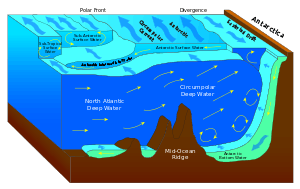Whirlpool


A whirlpool is a swirling body of water produced by the meeting of opposing currents. The vast majority of whirlpools are not very powerful. More powerful ones are properly termed maelstroms. Vortex is the proper term for any whirlpool that has a downdraft. Whirlpools in oceans are usually caused by tides. Very small whirlpools can easily be seen when a bath or a sink is draining, but these are produced in a very different manner from those in nature. Smaller whirlpools also appear at the base of many waterfalls.[1] In the case of powerful waterfalls, like Niagara Falls, these whirlpools can be quite strong. The most powerful whirlpools are created in narrow, shallow straits with fast flowing water.
Notable whirlpools
Some of the most notable whirlpools in the world are the Saltstraumen in Norway, which reaches speeds of 37 km/h (23 mph); the Moskstraumen also in Norway (the original maelstrom), which reaches speeds of 27.8 km/h (17.3 mph); the Old Sow in Canada, which has been measured with a speed of up to 27.6 km/h (17.1 mph); the Naruto whirlpools in Japan, which have a speed of 20 km/h (12 mph); and the Corryvreckan in Scotland, which reaches speeds of 18 km/h (11 mph).
Powerful whirlpools have killed unlucky seafarers, but their power tends to be exaggerated by laymen. There are virtually no stories of large ships ever being sucked into a whirlpool. Tales like those by Paul the Deacon, Edgar Allan Poe, and Jules Verne are entirely fictional.[2]
There was a short-lived whirlpool that sucked in a portion of Lake Peigneur in Louisiana, United States after a drilling mishap in 1980. This was not a naturally-occurring whirlpool, but a man-made disaster caused by breaking through the roof of a salt mine. The lake then behaved like a gigantic bathtub being drained, until the mine filled and the water levels equalized.
Dangers
Rarely, whirlpools can have the dangerous effect of destroying boats. In the 8th century, Paul the Deacon, who had lived among the Belgii, described tidal bores and the maelstrom for a Mediterranean audience unused to such violent tidal surges:
"Not very far from this shore … toward the western side, on which the ocean main lies open without end, is that very deep whirlpool of waters which we call by its familiar name "the navel of the sea." This is said to suck in the waves and spew them forth again twice every day. … They say there is another whirlpool of this kind between the island of Britain and the province of Galicia, and with this fact the coasts of the Seine region and of Aquitaine agree, for they are filled twice a day with such sudden inundations that any one who may by chance be found only a little inward from the shore can hardly get away. I have heard a certain high nobleman of the Gauls relating that a number of ships, shattered at first by a tempest, were afterwards devoured by this same Charybdis. And when one only out of all the men who had been in these ships, still breathing, swam over the waves, while the rest were dying, he came, swept by the force of the receding waters, up to the edge of that most frightful abyss. And when now he beheld yawning before him the deep chaos whose end he could not see, and half dead from very fear, expected to be hurled into it, suddenly in a way that he could not have hoped he was cast upon a certain rock and sat him down." Paul the Deacon, History of the Lombards, i.6
In "Vingt mille lieues sous les mers" (Twenty Thousand Leagues Under the Sea), first published in 1869–1870 in the magazine Magasin d'Éducation et de Récréation, Jules Verne (1828–1905) wrote:
- «Maelstrom! Maelstrom!» s'écriait-il! Le Maelstrom! Un nom plus effrayant dans une situation plus effrayante pouvait-il retentir à notre oreille?
Which translates "'Maelstrom! Maelstrom!' he exclaimed! The Maelstrom! Could a more horrifying name in a more frightening situation blare in our ear?"[3]
See also
References
- ↑ Carreck, Rosalind, ed. (1982). The Family Encyclopedia of Natural History. The Hamlyn Publishing Group. p. 246. ISBN 0711202257.
- ↑ Paul the Deacon, History of the Lombards (8th century AD); Edgar Allan Poe, "A Descent into the Maelström" (1841); and Jules Verne, Twenty Thousand Leagues Under the Sea (1870).
- ↑ Jolivet, Lindsay (2013-04-24). "Whirlpool in Latvian river swallows everything that enters | Daily Buzz". Yahoo! News Canada. Retrieved 2013-08-26.
Bibliography
- Baron PA, Willeke K (1986) Respirable droplets from whirlpools: measurements of size distribution and estimation of disease potential. Environ Res 39, 8-18.
External links
| Wikimedia Commons has media related to Whirlpools. |
| ||||||||||||||||||||||||||||


